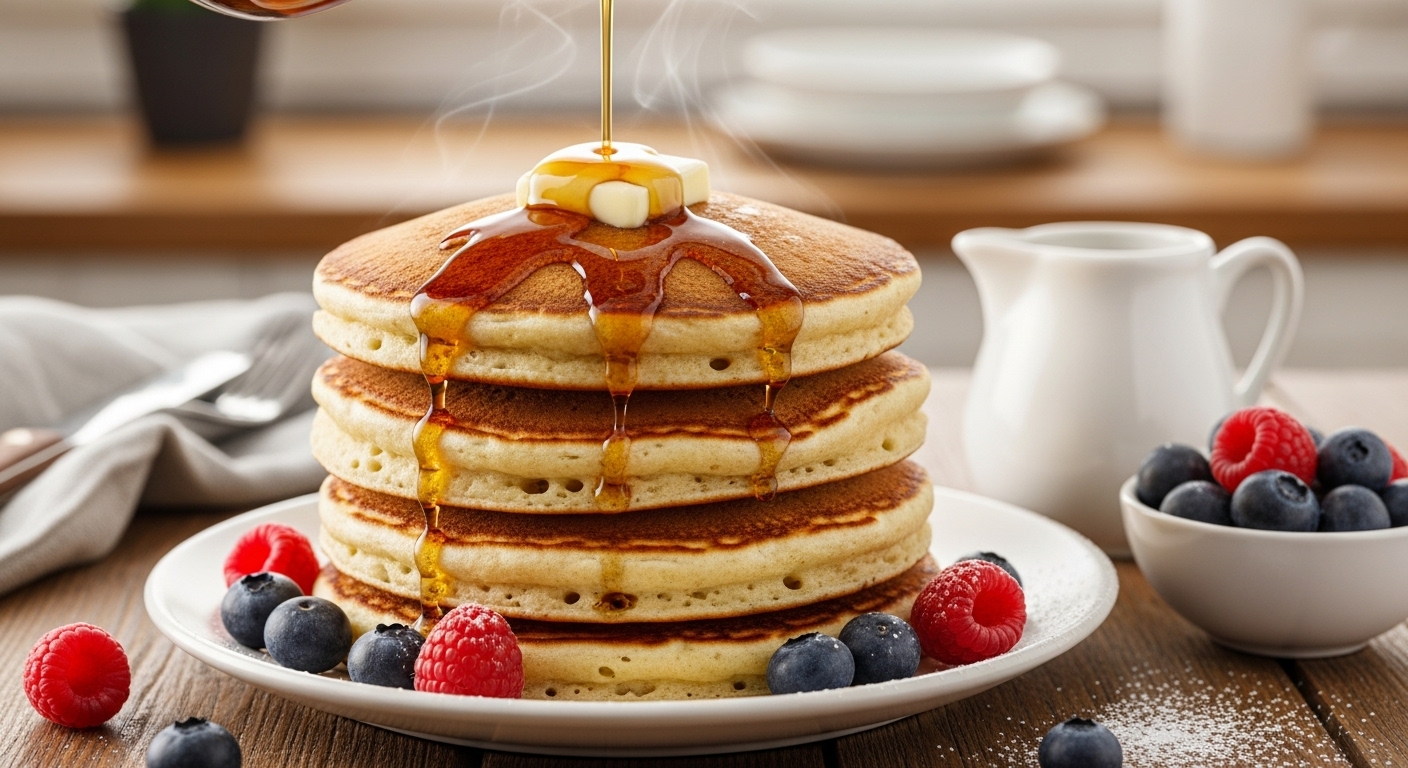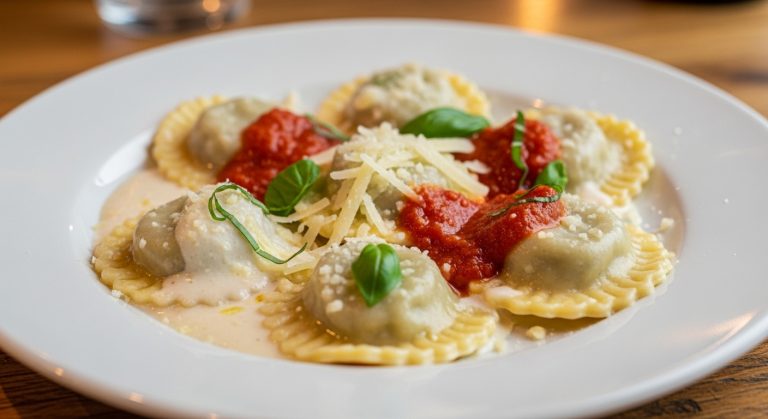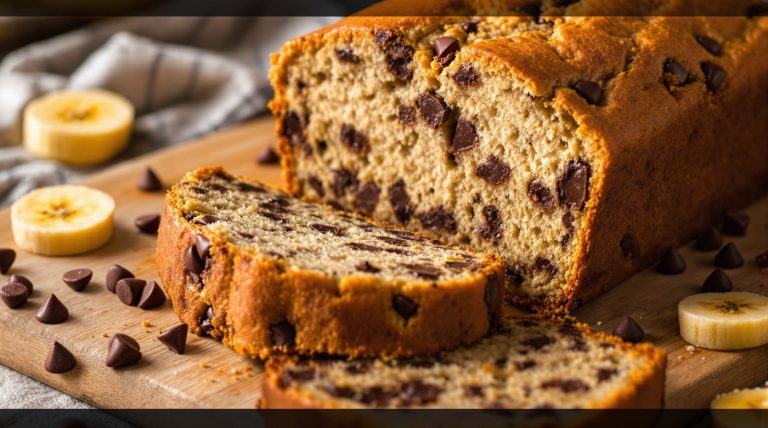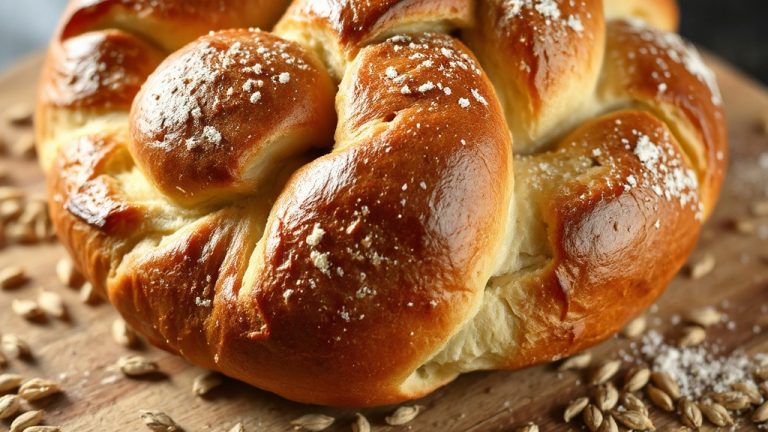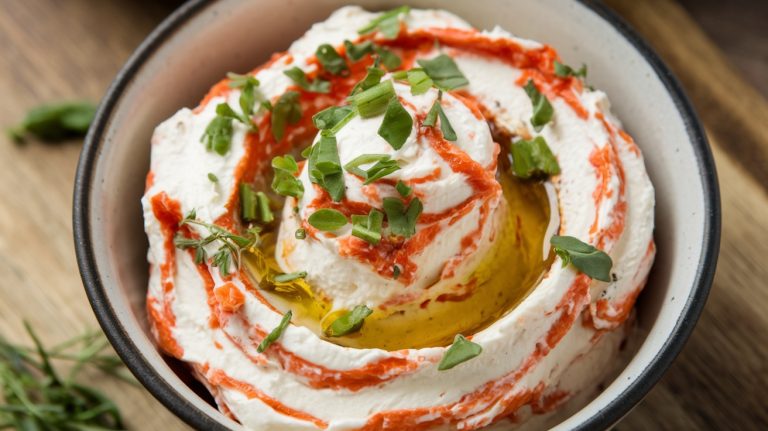Sourdough Discard Buttermilk Pancakes: Your Morning Flavor Upgrade
You can turn your sourdough discard into tender buttermilk pancakes by mixing it with fresh buttermilk, flour, eggs, and a touch of baking soda and powder for a perfect rise.
Whisk egg whites separately for extra fluff, then gently fold them in to keep the batter light and airy.
Let the batter rest for enhanced texture and tang.
These simple steps create golden, fluffy pancakes bursting with flavor, plus more tips and variations await to elevate your breakfast game.
Key Takeaways
- Use active sourdough discard and buttermilk to create tangy, tender pancakes with light, airy texture from fermentation and acidity reaction.
- Combine baking powder and baking soda with flour for optimal rise, measuring about 3/4 teaspoon each per 1.5 cups flour.
- Whisk eggs, buttermilk, discard, and sugar smoothly, then gently fold sifted dry ingredients and melted butter to preserve air bubbles.
- Fold in whipped egg whites and rest batter 20 minutes or overnight for enhanced fluffiness and flavor depth.
- Cook pancakes on a preheated, greased skillet, flipping when bubbles pop, then store or reheat properly to maintain freshness.
Buttermilk Sourdough Discard Pancakes Recipe Table
| Ingredients | Process |
|---|---|
| 1 cup sourdough discard (recently fed for best flavor) | Combine with buttermilk and eggs in the wet mix. Dissolves well and adds tang. |
| 1 ¼ cups buttermilk | Adds acidity for rise and tenderness. Mix into wet ingredients. |
| 2 large eggs (separate yolks and whites) | Whisk yolks into wet ingredients. Beat whites separately to stiff peaks, then fold in last. |
| 1 ½ cups all-purpose flour | Sift and fold into wet mix in thirds to keep texture light. |
| ¾ tsp baking soda | Adds lift by reacting with buttermilk. Ensure it’s fresh for best results. |
| ¾ tsp baking powder | Balances lift with the soda for ideal fluffiness. |
| 2 tbsp granulated sugar | Adds sweetness and caramelization. Stir into the wet mix. |
| 4 tbsp melted butter | Stir in last before egg whites to retain fluffiness. |
| ½ tsp salt | Balances flavor. Mix with dry ingredients. |
| 1 tsp vanilla extract | Adds aroma and richness to the batter. |
| (Optional: Berries, cinnamon, chopped nuts, banana, maple syrup) | Fold in after base batter is mixed for texture and customization. |
Ingredients and Their Roles
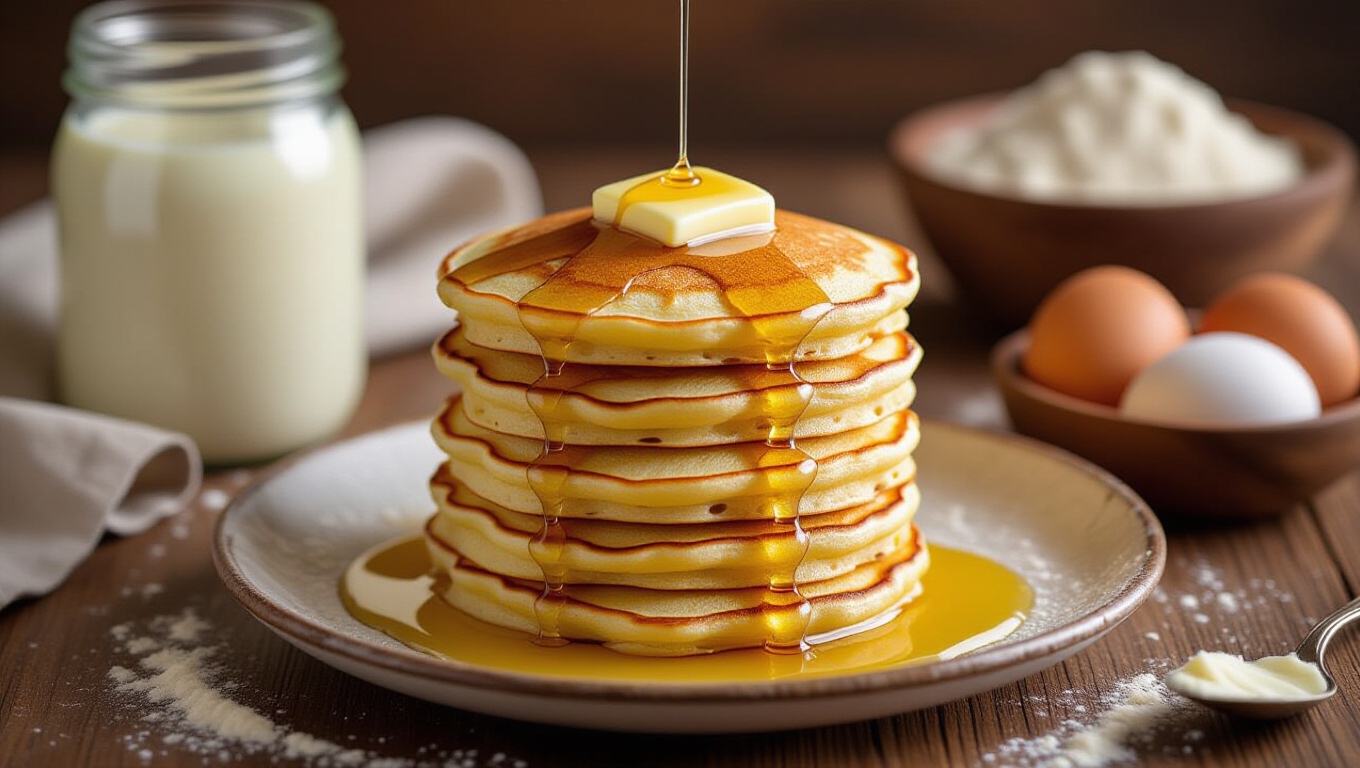
While sourdough discard might seem like just a kitchen leftover, it plays a starring role in these buttermilk pancakes by adding a natural tangy flavor and creating a light, airy texture through its fermentation.
You’ll find it provides mild yeast leavening, which works beautifully alongside baking soda and baking powder to lift the batter. For best results, use active, recently fed sourdough discard to maximize flavor and texture. Measuring the discard precisely with a digital kitchen scale ensures consistent batter quality.
Buttermilk brings acidity that reacts with baking soda, producing bubbles for a tender crumb and moistness, while complementing the discard’s tang.
Flour forms the pancake’s structure, trapping gas with its gluten networks to ensure fluffiness.
Eggs and butter enrich the batter, adding moisture, color, and aiding browning.
Sugar sweetens and enhances caramelization, salt balances flavors, and vanilla adds aromatic complexity.
Each ingredient plays a precise role, crafting pancakes that are deliciously light and flavorful.
Step-by-Step Preparation Guide
When you start your sourdough discard buttermilk pancake batter, begin by whisking together the eggs, buttermilk, sourdough discard, vanilla, and sugar until the discard fully dissolves and the mixture is smooth. Using sourdough discard not only reduces waste but also introduces the fermentation process that enhances flavor and digestibility.
Next, sift the flour, salt, baking powder, and baking soda into the wet mix, folding gently in thirds to keep the batter tender.
Stir in melted butter last to evenly distribute fat without deflating the batter. To enhance the fluffiness, it is recommended to fold in beaten egg whites just before cooking to increase loft and tenderness.
If you’re short on time, rest the batter for about 20 minutes; otherwise, prepare the sponge the night before by mixing discard, buttermilk, flour, sugar, and butter for an overnight ferment that deepens flavor.
Preheat your greased skillet over medium heat, pour about 1/3 cup batter per pancake, and flip when bubbles pop for perfectly cooked pancakes. Quick cooking helps preserve nutrients and maintains the tender texture characteristic of sourdough-based recipes.
Tips for Achieving Perfect Fluffiness
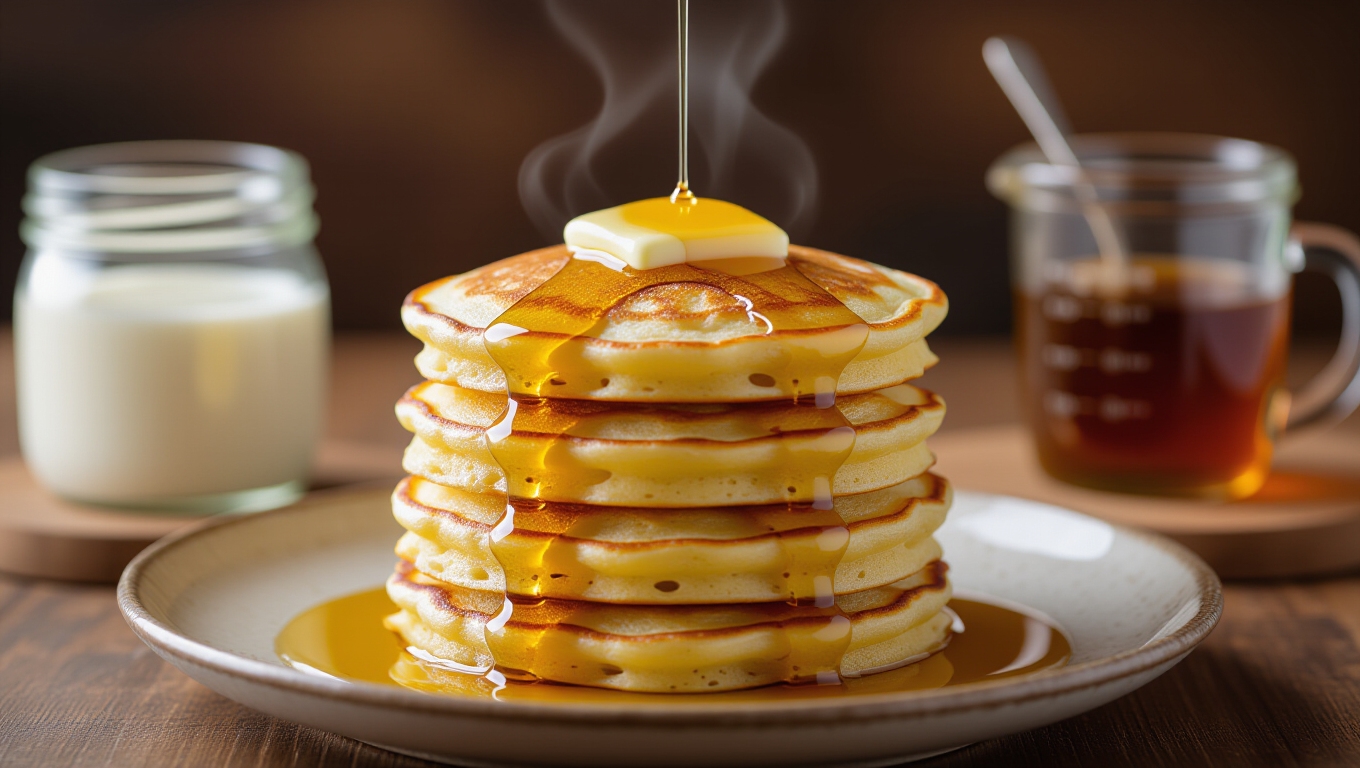
To get perfectly fluffy pancakes, start by whipping egg whites separately for an extra lift that lightens each bite.
Always use fresh baking powder and baking soda to guarantee your batter rises beautifully every time.
Mix your batter gently—overworking it can make your pancakes dense instead of tender and airy.
Letting the batter rest briefly before cooking allows the starches to swell and gluten to relax, improving fluffiness and texture.
Whip Egg Whites
Achieving perfectly fluffy egg whites often hinges on a few critical steps you mightn’t expect. First, use room-temperature whites separated carefully to avoid yolk contamination, which can hinder whipping. Resting the batter briefly before folding in the whites helps activate baking powder and improve the final texture. Using a clean, grease-free bowl is crucial to prevent fats from interfering with the egg whites’ volume.
Start whipping slowly in a clean, grease-free bowl to create small, stable air bubbles. Gradually increase speed until you reach stiff peaks—peaks that stand firmly without collapsing—ideal for folding into your batter. Watch closely to avoid overbeating, which causes dryness and separation. When incorporating, fold in a third of the whites gently to lighten the batter, then carefully add the rest, preserving air bubbles.
This technique boosts volume and bounce, transforming your sourdough discard buttermilk pancakes into irresistibly light, fluffy delights you’ll want every morning.
Use Fresh Leaveners
Because baking powder and baking soda lose their punch over time, using fresh leaveners is essential for pancakes that rise just right. You want to test baking powder by mixing a small amount with warm water—if it bubbles vigorously, it’s still active.
Baking soda should be stored airtight and dry, as moisture dulls its power. Using leaveners no older than six months ensures they react fully with the acidity of your sourdough discard and buttermilk, creating those perfect carbon dioxide bubbles for fluffiness.
Remember to measure carefully—about 3/4 teaspoon baking soda and equal parts baking powder per 1.5 cups of flour balance lift without off-flavors or excessive browning. Fresh, well-measured leaveners are your secret weapon for tender, airy pancakes every time.
Additionally, adding both baking soda and baking powder is important to ensure the pancakes are fluffy and light despite the natural leavening from sourdough.
Gentle Batter Mixing
When you mix your pancake batter gently, you preserve the delicate air bubbles that give each pancake its light, fluffy texture. Use a rubber spatula or large spoon to fold wet and dry ingredients slowly, lifting from the bottom to the top. Stop mixing as soon as no large flour clumps remain—some lumps are okay.
Avoid electric mixers and vigorous stirring, which break up the bubbles and activate gluten, making pancakes dense. After mixing, let your batter rest 5-15 minutes to hydrate the flour and stabilize bubbles, enhancing rise and tenderness.
Lightly whisk eggs beforehand to incorporate air, and combine ingredients separately before folding them together. This gentle mixing technique protects leavening gases, ensuring your sourdough discard buttermilk pancakes come out perfectly fluffy every time.
For best results, pour your batter onto a heated pan or griddle and cook until bubbles appear on top before flipping for even cooking and golden color on both sides, which helps maintain the fluffy texture. Freezing the batter can preserve the resistant starch benefits, making your pancakes both delicious and nutritionally advantageous.
Flavor Profile and Texture Insights
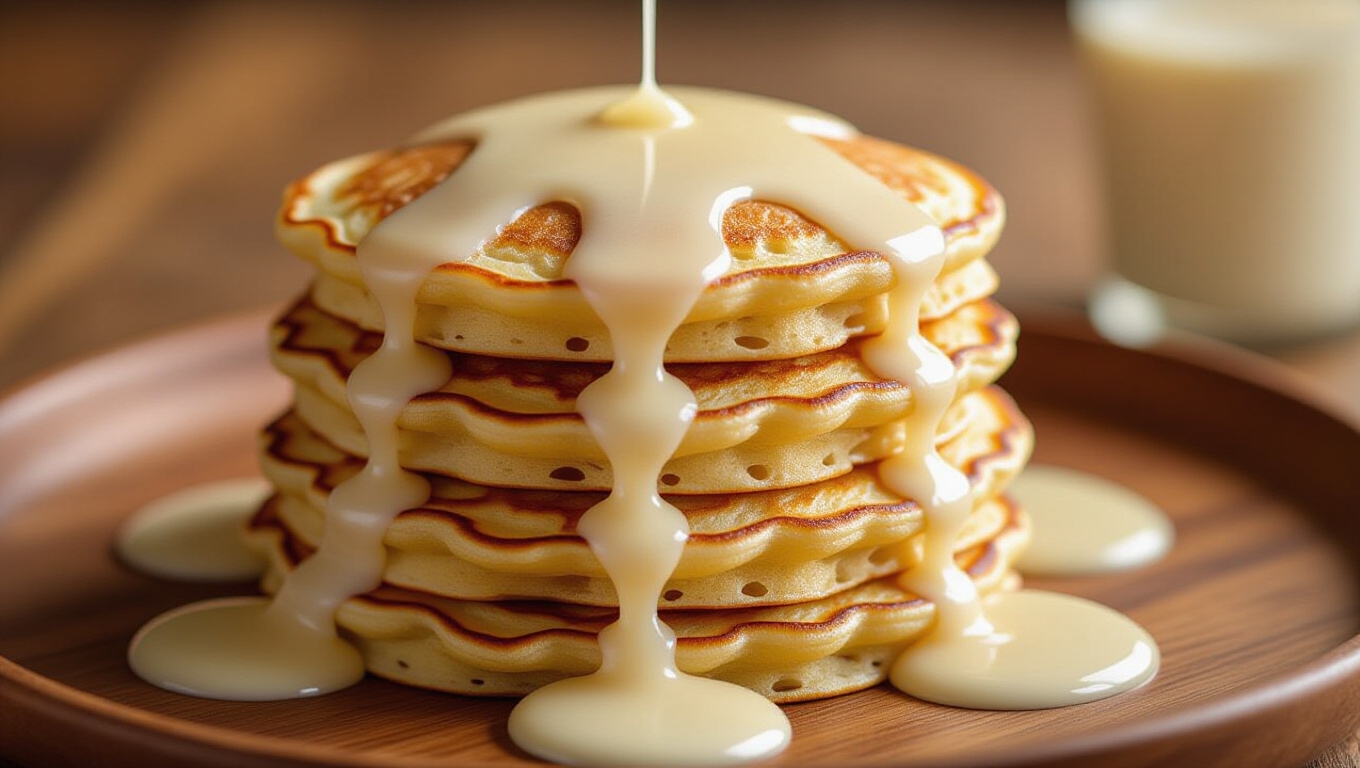
Although sourdough discard and buttermilk might seem like simple ingredients, they combine to create a pancake bursting with complex tangy flavors and a uniquely airy texture. You’ll notice the distinctive tang from sourdough’s natural acidity layered with buttermilk’s creamy tartness, balanced by warmth from butter and vanilla and a subtle sweetness from sugar.
This rich, slightly savory flavor sets these pancakes apart from regular ones.
Texture-wise, the batter’s perfect hydration and the acid-base reaction between sourdough, buttermilk, and leavening agents give you light, tender pancakes with crispy golden edges. Using a scale or spoon-and-level for measuring flour ensures consistent batter texture and pancake quality.
Inside, they’re soft and airy, thanks to gentle mixing and resting that boost rise and prevent toughness. Each bite delivers a delightful contrast of fluffy crumb and crisp exterior.
Variations and Customization Ideas
If you’re looking to personalize your sourdough discard buttermilk pancakes, a world of variations awaits to suit your taste and dietary needs. You can experiment with different flours like buckwheat or almond for unique flavors and textures. The natural fermentation used in sourdough can also provide a lower glycemic index, which may benefit health-conscious eaters.
Sweeten naturally with honey or add spices such as cinnamon for warmth. Mix in fresh berries or nuts to boost texture and nutrition. Don’t forget dairy swaps—try yogurt or plant milks to tweak tang and richness.
- Swap all-purpose flour with whole wheat or gluten-free oat flour for diverse textures.
- Sweeten with maple syrup, add vanilla extract, or fold in mashed bananas for moisture.
- Incorporate fruits like blueberries or nuts like walnuts for bursts of flavor and crunch.
- Use yogurt or almond milk instead of buttermilk to adjust tanginess and consistency. Resting the sponge overnight can enhance the pancakes’ fluffiness and tang, making your customized batter even more delightful.
Storage and Reheating Recommendations
To keep your sourdough discard buttermilk pancakes tasting fresh and delicious, proper storage and reheating are key.
Store leftovers in an airtight container in the fridge for up to 7 days, or freeze pancakes individually wrapped in plastic wrap inside freezer-safe bags for up to 3 months. Always let them cool completely before storing to prevent sogginess. Proper tools facilitate flipping and ensure even cooking, which also helps pancakes maintain their quality when reheated.
Keep pancakes fresh by refrigerating in airtight containers for a week or freezing wrapped individually up to three months
When reheating, you’ve got great options: warm them in a 350°F oven wrapped in foil for about 10 minutes, or crisp them up in a skillet with a little butter for 1-2 minutes per side. You can also toast thawed pancakes on low or use an air fryer at 350°F for 2-3 minutes. Avoid high microwave power; instead, cover with a damp towel and heat in short intervals to keep them moist.
Frequently Asked Questions
Can I Use Gluten-Free Flour for Sourdough Discard Pancakes?
You can definitely use gluten-free flour for sourdough discard pancakes. Combining super-fine almond and oat flours gives you a fluffy, flavorful batter with great texture.
Just remember to add baking powder and soda to help them rise, and let the batter rest to develop flavor and fluffiness.
Using gluten-free blends mimics gluten’s binding, so your pancakes won’t crumble. With the right flour mix and technique, you’ll enjoy tasty, tender pancakes every time!
How Do I Know if My Sourdough Discard Is Still Good to Use?
You’ll know your sourdough discard is good to use if it shows no pink or orange streaks, fuzzy mold, or off-putting smells like rotten cheese. A strong sour aroma is normal, and hooch—a dark liquid on top—is fine; just stir or pour it off.
If it’s not overly runny or dry, and hasn’t been unrefrigerated for over 36 hours, your discard should be safe and ready for baking.
What Is the Ideal Pan Temperature for Cooking These Pancakes?
If you want pancakes that’re golden brown and fluffy, you’ll want your pan around 300-350°F. Cook them at medium-low heat to avoid burning the outside while the inside stays raw.
Preheat your skillet fully and keep the heat steady—too hot and they’ll scorch, too cool and they’ll turn out pale and dense.
Watch for bubbles and dry edges before flipping for that perfect, light texture.
Can I Prepare the Batter Entirely on the Same Day Without Fermentation?
Yes, you can prepare the batter entirely on the same day without fermentation. Just mix the wet ingredients, including sourdough discard and buttermilk, with the dry ones, then let it rest for about 20 minutes.
This brief rest hydrates the flour and activates enzymes slightly, so you’ll get fluffy, tender pancakes with mild tanginess. The baking soda and buttermilk’s acidity will do the heavy lifting for fluffiness and flavor.
Are These Pancakes Suitable for People With Egg Allergies?
You might hope to enjoy those fluffy pancakes even with an egg allergy, but here’s the catch: eggs are essential for their light texture and rise. Without eggs or a carefully tested substitute, your pancakes could turn dense and flat.
Since traditional recipes don’t offer egg-free versions, you’ll need to explore alternative recipes or egg replacers cautiously. So, if you’re allergic, it’s safer to skip these and try pancakes made specifically without eggs.
Your Breakfast, Reinvented
Now that you’ve mastered these sourdough discard buttermilk pancakes, imagine the warm, tangy aroma filling your kitchen each morning.
But here’s the twist—your discard, often overlooked, transforms into the secret ingredient for irresistibly fluffy pancakes with a subtle depth of flavor.
Don’t rush to toss that starter! Instead, savor the magic it brings to your breakfast table.
Ready to flip the ordinary into something extraordinary? Your next bite might just surprise you.

